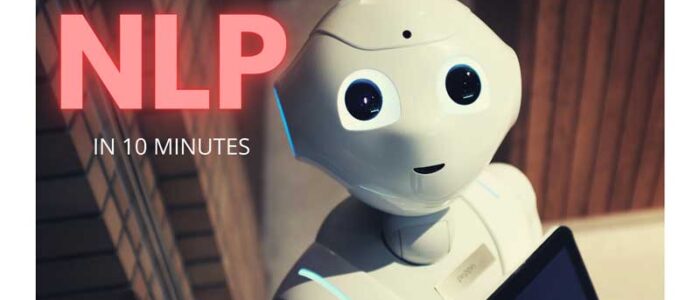Bienvenido, me llamo Luis y esta vez les traigo un post.
Estás aquí porque también quieres aprender el procesamiento del lenguaje natural lo más rápido posible, como yo.
Índice
Empecemos
Lo primero que necesitamos es instalar alguna dependencia
1. Python> 3.7.
2. Descargue un IDE o instale un cuaderno Jupyter.
Para instalar el cuaderno Jupyter, simplemente abra su cmd (terminal) y escriba pip install jupyter-notebook después de ese tipo jupyter notebook para ejecutarlo, puede ver que su computadora portátil está abierta en http://127.0.0.1:8888/ token.
3. Instalar paquetes
pip install nltk
NLTK: Es una librería de Python que podemos utilizar para realizar todas las tareas de PNL (lematización, lematización, etc.)
Antes de aprender algo, primero comprendamos la PNL.
Podemos decir que NLP (procesamiento del lenguaje natural) es una forma que ayuda a las computadoras a comunicarse con los humanos en su propio idioma.
Es uno de los campos de investigación más amplios porque existe una gran cantidad de datos y, a partir de esos datos, una gran cantidad de datos son datos de texto.
Entonces, cuando hay tantos datos disponibles, necesitamos alguna técnica que podamos procesar y recuperar información útil de ellos.
Ahora que entendemos qué es la PNL, comencemos a comprender cada tema uno por uno.
1. Tokenización (Tokenization)
La tokenización es el proceso de dividir todo el texto en tokens.
Es principalmente de dos tipos:
- Tokenizer de palabras (separados por palabras).
- Tokenizer de oración (separado por oración).
import nltk from nltk.tokenize import sent_tokenize,word_tokenize example_text = "Hello there, how are you doing today? The weather is great today. The sky is blue. python is awsome" print(sent_tokenize(example_text)) print(word_tokenize(example_text))
En el código anterior. Primero, estamos importando nltk , en la segunda línea, estamos importando nuestros tokenizadores sent_tokenize,word_tokeniz de la biblioteca nltk.tokenize , luego, para usar el tokenizador en un texto, sólo necesitamos pasar el texto como un parámetro en el tokenizador.
La salida se verá así
##sent_tokenize (Separated by sentence) ['Hello there, how are you doing today?', 'The weather is great today.', 'The sky is blue.', 'python is awsome'] ##word_tokenize (Separated by words) ['Hello', 'there', ',', 'how', 'are', 'you', 'doing', 'today', '?', 'The', 'weather', 'is', 'great', 'today', '.', 'The', 'sky', 'is', 'blue', '.', 'python', 'is', 'awsome']
2. Palabras vacías (Stopwords)
En general, las palabras vacías son las palabras en cualquier idioma que no agregan mucho significado a una oración. En PNL, las palabras vacías son aquellas palabras que no son importantes para analizar los datos.
Ejemplo: él, ella, hola, etc.
Hay un total de 179 palabras vacías en inglés, usando NLTK podemos ver todas las palabras vacías en inglés.
Solo necesitamos importar stopwords de la biblioteca nltk.corpus .
from nltk.corpus import stopwords
print(stopwords.words('english'))
######################
######OUTPUT##########
######################
['i', 'me', 'my', 'myself', 'we', 'our', 'ours', 'ourselves', 'you',
"you're", "you've", "you'll", "you'd", 'your', 'yours', 'yourself',
'yourselves', 'he', 'him', 'his', 'himself', 'she', "she's", 'her',
'hers', 'herself', 'it', "it's", 'its', 'itself', 'they', 'them',
'their', 'theirs', 'themselves', 'what', 'which', 'who', 'whom',
'this', 'that', "that'll", 'these', 'those', 'am', 'is', 'are',
'was', 'were', 'be', 'been', 'being', 'have', 'has', 'had', 'having',
'do', 'does', 'did', 'doing', 'a', 'an', 'the', 'and', 'but', 'if',
'or', 'because', 'as', 'until', 'while', 'of', 'at', 'by', 'for',
'with', 'about', 'against', 'between', 'into', 'through', 'during',
'before', 'after', 'above', 'below', 'to', 'from', 'up', 'down',
'in', 'out', 'on', 'off', 'over', 'under', 'again', 'further',
'then', 'once', 'here', 'there', 'when', 'where', 'why', 'how',
'all', 'any', 'both', 'each', 'few', 'more', 'most', 'other', 'some',
'such', 'no', 'nor', 'not', 'only', 'own', 'same', 'so', 'than',
'too', 'very', 's', 't', 'can', 'will', 'just', 'don', "don't",
'should', "should've", 'now', 'd', 'll', 'm', 'o', 're', 've', 'y',
'ain', 'aren', "aren't", 'couldn', "couldn't", 'didn', "didn't",
'doesn', "doesn't", 'hadn', "hadn't", 'hasn', "hasn't", 'haven',
"haven't", 'isn', "isn't", 'ma', 'mightn', "mightn't", 'mustn',
"mustn't", 'needn', "needn't", 'shan', "shan't", 'shouldn',
"shouldn't", 'wasn', "wasn't", 'weren', "weren't", 'won', "won't",
'wouldn', "wouldn't"]
Para eliminar palabras vacías para un texto en particular
from nltk.corpus import stopwords
text = 'he is a good boy. he is very good in coding'
text = word_tokenize(text)
text_with_no_stopwords = [word for word in text if word not in stopwords.words('english')]
text_with_no_stopwords
##########OUTPUT##########
['good', 'boy', '.', 'good', 'coding']
3. Derivado (Stemming)
Derivado es el proceso de reducir una palabra a su raíz de palabra que se agrega a sufijos y prefijos o a las raíces de palabras conocidas como lema.
En palabras simples, podemos decir que derivar es el proceso de eliminar el plural y los adjetivos de la palabra.
Ejemplo :
amado → amar, aprender → aprender
En Python, podemos implementar la derivación usando PorterStemmer. podemos importarlo de la biblioteca nltk.stem.
from nltk.stem import PorterStemmer
ps = PorterStemmer() ## Creating an object for porterstemmer
example_words = ['earn',"earning","earned","earns"] ##Example words
for w in example_words:
print(ps.stem(w)) ##Using ps object stemming the word
##########OUTPUT##########
earn
earn
earn
earn
Here we can see that earning,earned and earns are stem to there lemma or root word earn.
4. Lematizante (Lemmatizing)
Lematización generalmente se refiere a hacer las cosas correctamente con el uso de vocabulario y análisis morfológico de palabras, normalmente con el objetivo de eliminar solo las terminaciones flexivas y devolver la forma base o diccionario de una palabra, lo que se conoce como lema.
En palabras simples, la lematización hace el mismo trabajo que la derivación, la diferencia es que la lematización devuelve una palabra significativa.
Ejemplo:
Derivado
historia → histori
Lematizante
historia → historia
from nltk.stem import WordNetLemmatizer lemmatizer = WordNetLemmatizer() ## Create object for lemmatizer example_words = ['history','formality','changes'] for w in example_words: print(lemmatizer.lemmatize(w)) #########OUTPUT############ ----Lemmatizer----- history formality change -----Stemming------ histori formal chang
5. WordNet
WordNet es la base de datos léxica, es decir, un diccionario para el idioma inglés, diseñado específicamente para el procesamiento del lenguaje natural.
Nosotros podemos usar wordnet para encontrar sinónimos y antónimos.
En Python, podemos importar wordnet desde nltk.corpus.
from nltk.corpus import wordnet
synonyms = [] ## Creaing an empty list for all the synonyms
antonyms =[] ## Creaing an empty list for all the antonyms
for syn in wordnet.synsets("happy"): ## Giving word
for i in syn.lemmas(): ## Finding the lemma,matching
synonyms.append(i.name()) ## appending all the synonyms
if i.antonyms():
antonyms.append(i.antonyms()[0].name()) ## antonyms
print(set(synonyms)) ## Converting them into set for unique values
print(set(antonyms))
#########OUTPUT##########
{'felicitous', 'well-chosen', 'happy', 'glad'}
{'unhappy'}
6. Parte del etiquetado de voz (Part of Speech Tagging)
Es un proceso de convertir una oración en formas: una lista de palabras, una lista de tuplas (donde cada tupla tiene una forma (palabra, etiqueta)). La etiqueta en el caso es una etiqueta de parte del discurso y significa si la palabra es un sustantivo, adjetivo, verbo, etc.
CC coordinating conjunction CD cardinal digit DT determiner EX existential there (like: “there is” … think of it like “there”) FW foreign word IN preposition/subordinating conjunction JJ adjective ‘big’ JJR adjective, comparative ‘bigger’ JJS adjective, superlative ‘biggest’ LS list marker 1) MD modal could, will NN noun, singular ‘desk’ NNS noun plural ‘desks’ NNP proper noun, singular ‘Harrison’ NNPS proper noun, plural ‘Americans’ PDT predeterminer ‘all the kids’ POS possessive ending parent’s PRP personal pronoun I, he, she PRP possessive pronoun my, his, hers RB adverb very, silently, RBR adverb, comparative better RBS adverb, superlative best RP particle give up TO to go ‘to’ the store. UH interjection errrrrrrrm VB verb, base form take VBD verb, past tense took VBG verb, gerund/present participle taking VBN verb, past participle taken VBP verb, sing. present, non-3d take VBZ verb, 3rd person sing. present takes WDT wh-determiner which WP wh-pronoun who, what WP possessive wh-pronoun whose WRB wh-abverb where, when
En Python, podemos hacer etiquetado pos usando nltk.pos_tag .
import nltk
nltk.download('averaged_perceptron_tagger')
sample_text = '''
An sincerity so extremity he additions. Her yet there truth merit.
Mrs all projecting favourable now unpleasing. Son law garden chatty temper.
Oh children provided to mr elegance marriage strongly.
Off can admiration prosperous now devonshire diminution law.
'''
from nltk.tokenize import word_tokenize
words = word_tokenize(sample_text)
print(nltk.pos_tag(words))
################OUTPUT############
[('An', 'DT'), ('sincerity', 'NN'), ('so', 'RB'), ('extremity',
'NN'), ('he', 'PRP'), ('additions', 'VBZ'), ('.', '.'), ('Her',
'PRP$'), ('yet', 'RB'), ('there', 'EX'), ('truth', 'NN'), ('merit',
'NN'), ('.', '.'), ('Mrs', 'NNP'), ('all', 'DT'), ('projecting',
'VBG'), ('favourable', 'JJ'), ('now', 'RB'), ('unpleasing', 'VBG'),
('.', '.'), ('Son', 'NNP'), ('law', 'NN'), ('garden', 'NN'),
('chatty', 'JJ'), ('temper', 'NN'), ('.', '.'), ('Oh', 'UH'),
('children', 'NNS'), ('provided', 'VBD'), ('to', 'TO'), ('mr', 'VB'),
('elegance', 'NN'), ('marriage', 'NN'), ('strongly', 'RB'), ('.',
'.'), ('Off', 'CC'), ('can', 'MD'), ('admiration', 'VB'),
('prosperous', 'JJ'), ('now', 'RB'), ('devonshire', 'VBP'),
('diminution', 'NN'), ('law', 'NN'), ('.', '.')]
7. Bolsa de palabras (Bag of words)
Hasta ahora hemos entendido sobre tokenizar, derivar y lematizar. todos estos son parte de la limpieza del texto, ahora, después de limpiar el texto, necesitamos convertir el texto en algún tipo de representación numérica llamada vectores para que podamos enviar los datos a un modelo de aprendizaje automático para su posterior procesamiento.
Para convertir los datos en vectores, utilizamos algunas bibliotecas predefinidas en Python.
Veamos cómo funciona la representación vectorial.
sent1 = he is a good boy
sent2 = she is a good girl
sent3 = boy and girl are good
|
|
After removal of stopwords , lematization or stemming
sent1 = good boy
sent2 = good girl
sent3 = boy girl good
| ### Now we will calculate the frequency for each word by
| calculating the occurrence of each word
word frequency
good 3
boy 2
girl 2
| ## Then according to their occurrence we assign o or 1
| according to their occurrence in the sentence
| ## 1 for present and 0 fot not present
f1 f2 f3
girl good boy
sent1 0 1 1
sent2 1 0 1
sent3 1 1 1
### After this we pass the vector form to machine learning model
El proceso anterior se puede realizar utilizando un CountVectorizer en Python, podemos importar lo mismo desde sklearn.feature_extraction.text .
import pandas as pd
sent = pd.DataFrame(['he is a good boy', 'she is a good girl', 'boy
and girl are good'],columns=['text'])
corpus = []
for i in range(0,3):
words = sent['text'][i]
words = word_tokenize(words)
texts = [lemmatizer.lemmatize(word) for word in words if word not in set(stopwords.words('english'))]
text = ' '.join(texts)
corpus.append(text)
print(corpus) #### Cleaned Data
from sklearn.feature_extraction.text import CountVectorizer
cv = CountVectorizer() ## Creating Object for CountVectorizer
X = cv.fit_transform(corpus).toarray()
X ## Vectorize Form
############OUTPUT##############
['good boy', 'good girl', 'boy girl good']
array([[1, 0, 1],
[0, 1, 1],
[1, 1, 1]], dtype=int64)
Felicitaciones, ahora conoce los conceptos básicos de la PNL.
Gracias por leer y no te olvides de compartir tus opiniones a continuación.








Añadir comentario